Apple's 2010 MacBook Air (11 & 13 inch) Thoroughly Reviewed
by Anand Lal Shimpi on October 26, 2010 10:08 PM EST- Posted in
- Mac
- Apple
- MacBook Air
- Laptops
The SSD: Not Half Bad
Apple advertises the new MacBook Air as being instant on as a result of the internal SSD. That’s mostly untrue. From a completely powered off state the MacBook Air still takes time to boot. That time is significantly reduced compared to the old MacBook Air and any other Mac with a conventional hard drive. It’s even a shorter boot than my MacBook Pro with a SandForce SF-1200 based SSD in it:
| System Performance Comparison | ||||||
| Boot | Shut Down | Sleep | Awake | |||
| 11-inch MacBook Air | 15.5 seconds | 2.2 seconds | 1.0 second | 1.63 seconds | ||
| 13-inch MacBook Air | 14.4 seconds | 1.9 seconds | 1.0 second | 1.56 seconds | ||
| 13-inch MacBook Air (Late 2008) | 34.4 seconds | 2.9 seconds | 1.6 seconds | 4.19 seconds | ||
| 15-inch MacBook Pro (SF-1200 SSD) | 19.1 seconds | 1.8 seconds | 1.5 seconds | 2.3 seconds | ||
| 15-inch MacBook Pro (Mid 2009, HDD) | 34.2 seconds | 2.8 seconds | 1.8 seconds | 2.1 seconds | ||
You'll notice that even the SF-1200 SSD in my 15-inch MacBook Pro takes longer to boot than these new Airs. Apple does customize the firmware on its SSDs. I’d be willing to bet the SSD in the MacBook Air has tight integration with OS X to guarantee quicker than normal boot times.
Clearly the new Air isn't instant on from a boot standpoint, but it's pretty much there from a recover-from-sleep standpoint. The new Airs both go to sleep and wake up from sleep quicker than any of the other Macs, including my upgraded 15-inch Core i7 MacBook Pro. Again, nothing can trump Apple's tight integration between hardware and software.
Apple likes to work with two different controller manufacturers for SSDs: Samsung and Toshiba. iFixit already confirmed Toshiba is in the new MacBook Air with its teardown:
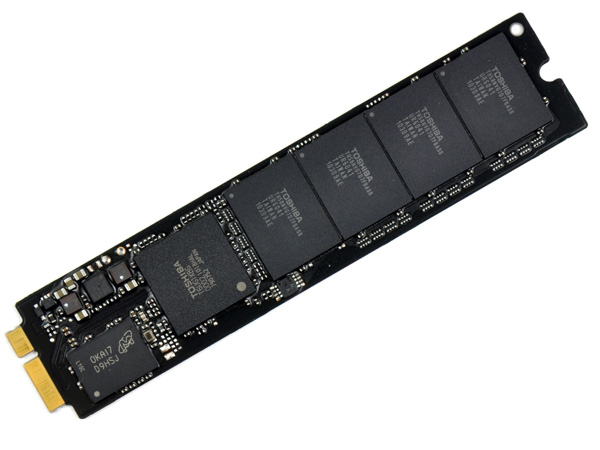
The 11-inch MacBook Air SSD, courtesy of iFixit
The SSD isn’t in an industry standard form factor, although the connector appears to be either micro or mini SATA. Presumably 3rd party SSD manufacturers (ahem, SandForce partners I’m looking at you) could produce drop in replacements for the MacBook Air SSD.
There’s nothing particularly innovative about the form factor of the SSD, other than Apple did away with the unnecessary space a 2.5” SSD would require. Just as SSDs will break the traditional SATA interface barriers, we’ll see the same happen to form factors as well.
The part number on the Toshiba controller may look familiar to some of you. It’s the same controller that’s in Kingston’s SSDNow V+ Series and the SSDNow V Series Boot Drive. I reviewed the latter not too long ago and found that it was a good drive for the money, and here’s the kicker: the SSDNow V Series Boot Drive was amazingly resilient when written to without TRIM support. Its performance hardly dropped as a result of normal desktop use. This is very important because although OS X 10.6.4 has a field for reporting TRIM support on an SSD, the instruction isn’t actually supported by the OS. Even the new MacBook Airs don’t ship with a version of OS X with TRIM support.
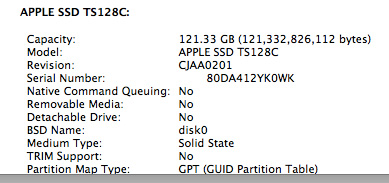
The SSD only has four NAND devices on it. Typically that would mean some very low transfer speeds, particularly on writes. But each one of those four devices has at least 16GB of NAND, spread across multiple planes and die. With the right firmware, you should be able to extract a good deal of parallelism from this architecture. Apple and Toshiba apparently do just that.

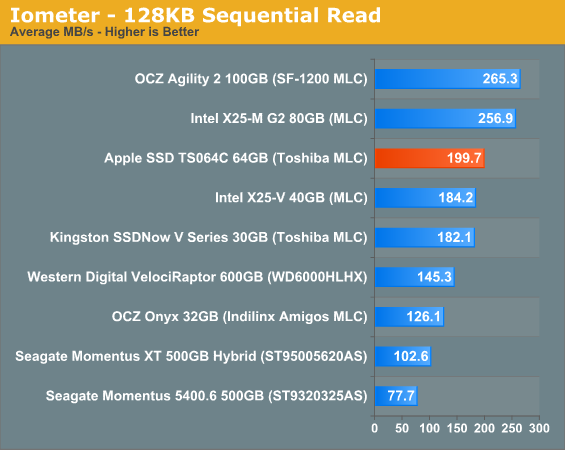
While most value SSDs top out at under 100MB/s, we get nearly 200MB/s sequential reads and writes out of the SSD in the new MacBook Air. And fortunately, Apple hasn’t only focused on sequential performance. The random read/write performance of the new MacBook Air SSD isn’t terrible:
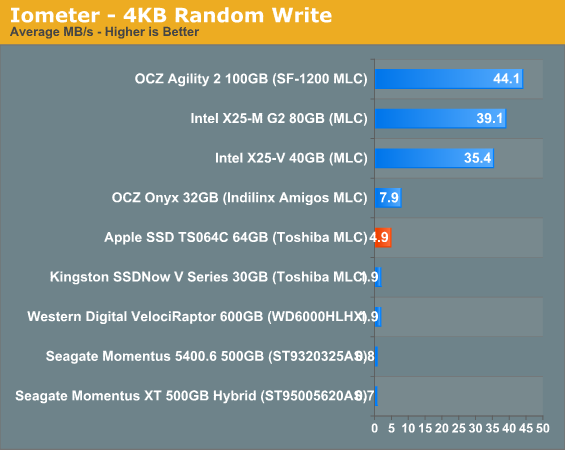
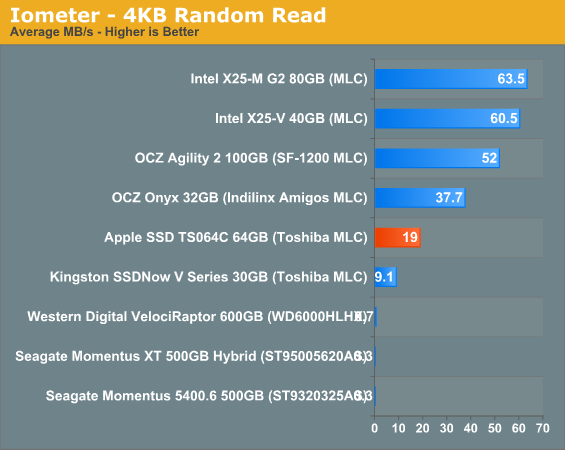
Random write performance is of course the weak point, but you’ll notice that it’s actually higher than the Kingston drive that uses the same controller. While Apple would’ve been better off striking a deal with Intel or SandForce for the controller in the MacBook Air, the Toshiba controller isn’t horrible.
As I mentioned earlier, resilience is very important as OS X still doesn’t support TRIM. I filled the drive with garbage and then tortured it for 20 minutes with random writes. The resulting performance drop was noticeable, but not unbearable:
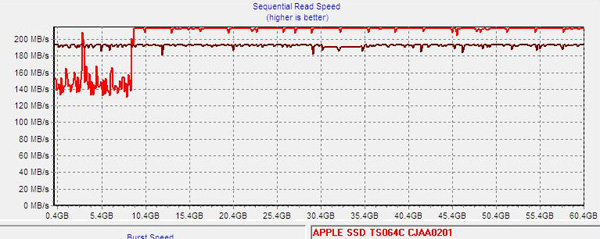
A single pass of sequential writes restores performance to normal:
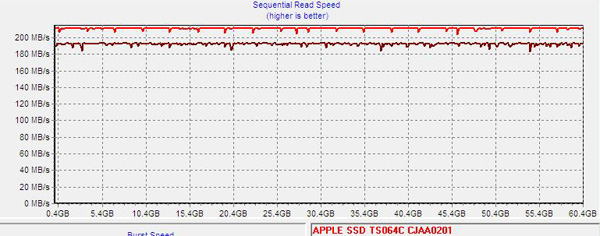
This tells us two things. First, through normal use the drive should be able to recover its performance over time (assuming you give it enough spare area). And second, if there’s any idle garbage collection in Apple’s custom firmware for the Toshiba controller it should be able to keep the drive running at peak performance even without TRIM supported in the OS. I don’t have a good way of measuring whether or not there’s GC enabled on the drive in OS X, but I suspect Apple is (at least it appears to be doing so on the Mac Pro’s SSDs).
Overall I’m pleased with Apple’s SSD selection. It could’ve been a lot better but it could’ve been a lot worse. The MacBook Airs in their default configuration have better IO performance than any other standard config Mac sold on the market today, including the Mac Pro.










185 Comments
View All Comments
Anand Lal Shimpi - Wednesday, October 27, 2010 - link
Not at all. But workloads, even within a given field, have grown much more intense over the past 5 years. While my example was simply photo editing, compile times for large projects should also be much longer on the 11 compared to any of the Core i-series platforms today. I'm not saying it can't be done, I'm saying you'll begin to impact productivity as a result.Obviously what you do for a living is real work - it'd just take longer on the 11-inch MBA vs. one of the MBPs.
Take care,
Anand
lemonadesoda - Thursday, October 28, 2010 - link
I've added a different usage picture for comparison. My "real work" workflow is something like this:1/ Read emails
2/ Read attachments, e.g. word, excel, PDF documents
3/ Take phone calls on VoIP/skype
4/ Log in to corporate webserver, check activity
5/ Send emails
6/ Write offers, workplans, status reports, invoices, in word. Convert to PDF
7/ Review training material/videos incl. created by us on SD card
8/ Fool around on the web during breaks
9/ Check anandtech
10/ Check emails
11/ Prepare articles and presentations, use a beamer (VGA D-SUB)
12/ Online banking
My "real play" workflow is something like this
1/ Read emails
2/ Fool around on the internet
3/ Play a few flash games with my kids
4/ Download pictures from camera on SD card
5/ Check, select, fix, upload to fileserver/website
6/ Download a video from my camcorder
7/ Upload to youtube
8/ Read anandtech
No, I do not expect to use my "netbook" for DirectX gaming. Not sure why everyone wants to do this. Havent they got a full-size desktop for this. A "netbook" has a different life-purpose and shouldnt be expected to replace a desktop.
On an Atom netbook, my workflows struggle with the video material and skype video. Skype audio is OK.
On the Apple 11" the workflows would be fine except we are missing the SD card slot. PITA for me. Not sure how we would connect to a beamer. I guess some kind of "converter dongle" would be needed to get from displayport to D-SUB VGA which is what 99% of beamers (and their room installations) require.
titeroper - Wednesday, October 27, 2010 - link
Anand and gang and fellow forumites - I know I may be shot down for asking this, but perhaps for xmas, can you write a quick article on how you think Apple will deal with Sandy Bridge upgrades early next year for MBP's?How does Nvidia fit in? Is there space for both a dedicated 400m series GPU + Intel HD and Sandy Bridge? Is it as easy as updating the current 2010 config with these parts?
I hope someone can help answer here, as I am looking forward to this update come Q!/Q2 2011.
Pantsu - Wednesday, October 27, 2010 - link
I'll soon update my old white macbook of early 2008, but this isn't quite up to snuff. While the form factor is superb, everything else is not. Weak CPU, only 2GB memory, limited although fast storage, and of course the price. It's probably better to wait for Sandy Bridge or Zacate in early 2011. Those should really bring something new, and I hope Apple will update the MacBook Pro at that time, otherwise I'll have to go Windows again, which I don't care to do in a laptop environment.new-paradigm - Wednesday, October 27, 2010 - link
Just looking at the specs of the 11.6" MBA, and the fact that it's 11.6" ... can apple honestly claim not to be in the netbook game anymore?Seriously, any laptop under 12" in screen size is a netbook, and bizzarely apple's reasoning behind omitting the dvd drive and other sundry pieces of usual hardware/connectivity (i.e. expected use and target audience) is almost exactly the same as those used when explaining their omission on netbboks.
SraCet - Wednesday, October 27, 2010 - link
The term "netbook" was coined to describe the small cheap laptops that were coming out a couple years ago with 7" screens, miniature keyboards, and barely enough storage space to run Linux. NETbook because they were only powerful enough to do basic web surfing--get it?Now everybody is calling every small laptop a "netbook," I guess because the word sounds cool, and everybody has their own made-up criteria for what is and isn't a netbook.
If you want to arbitrarily declare that anything with a < 12" screen is a netbook then fine. But surely you realize this isn't what Steve Jobs was referring to when he expressed his displeasure with "netbooks."
lemonadesoda - Thursday, October 28, 2010 - link
The word "netbook" is a living and evolving term. I don't think it was coined to have a fixed meaning of "cheap and 7 inch" and nothing else! Many years ago a laptop was something that was 11-13". Now we have laptops with 15" and 17" screens. Nobody is shouting "you cant call it a laptop, it doesnt sit on your lap anymore". The term laptop has evolved. Just as has the term desktop. Does desktop have to mean a very expensive Intel 386 with ISA, PCI, floppy and VDU? No, of course not.I think it is better to let the term netbook be defined as a "underspecced compared to a workstation" and "portable enough to put in your briefcase" and "powerful enough to run "net" applications" then I think we can allow the Apple 11" to be called a netbook. It is helping to redefine the term netbook perhaps, just like a mercedes or bmw has redefined our expectations of what a car is, or can be.
webdev50 - Wednesday, October 27, 2010 - link
Unfortunately, reviews like these don't consider how these machines will hold up after you start using them on a daily basis. Apple's equipment is developing a notorious reputation for having quality control issues. Search TS2377 on Google. Apple is using commodity hardware just like other manufacturers do, so Apple's equipment is prone to failure like everyone else's, regardless of price.My 2008 MacBook Pro 17" was repaired twice for the same Nvidia issue within a couple of months this year, so I switched to a Windows 7 machine instead because I need a reliable computer. I still have my MacBook Pro, but I'm running a stress test on it 12 hours a day trying to break it so I can get it replaced from Apple. When I get the replacement, I'm not even going to open the box; just sell it on craigslist.
Sure, OS X is pretty, but what good is it if the hardware is unreliable? And I can't legally use OS X on anything but Apple hardware. (Besides, after using Mac OS X software for 7 years, I've actually found it to be quite limiting and not as robust and mature as Windows software.) I'm not going to buy more than one Mac just so I can have a spare to use while Apple spends weeks repairing my computer.
Dealing with the "Geniuses" at the Apple Store can be very unpleasant too. When I called Apple Tech Support to verify what I was told at the Apple Store, they suggested I go to another Apple Store.
What am I supposed to use when my Mac breaks down and is getting repaired? It's cheaper to buy two Windows machines if one of them needs to be repaired than to buy one Mac.
My perspective now is not to buy anything from Apple that can't be immediately swapped if it's faulty. An iPhone or iPod can be quickly swapped out. Macs need to go through Apple's three-ring circus to get repaired. And who knows what the gorillas in the back room are going to do with it (and the spinning hard drive)? After I got my machine back from them, I needed to clean the lens on the DVD drive so I could burn a backup DVD. I don't want to know what they stuck in my DVD drive.
iwodo - Wednesday, October 27, 2010 - link
Isn't that a known issues that happen on ANY nvidia Gfx Laptop?AMDJunkie - Wednesday, October 27, 2010 - link
iwodo is right. HP, Dell, anyone who used the mobile (and desktop) Nvidia 8600 chip was affected. Research "bumpgate."I think Apple's pretty damn generous to have a program in place to replace your logic board, even out of warranty, seeing as just last month Nvidia finally settled and made a page for owners of PCs with the afflicted chips to get refunds or repairs. If you had an HP, I had heard (hearsay, now), that if you were out of warranty, tough, and this was the only (and only recently available) recourse.
I know for a fact that Apple's not as generous to give you a whole new model though, as long as it's for the graphics issue. Your best bet is to go here:
http://www.nvidiasettlement.com/